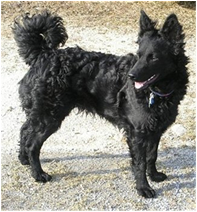|
The Canine Chronicles Directory
Mudi

The Mudi (also known as the Hajtokutya, Mudik (plural), Hungarian Mudi) is a medium-sized
herding dog with Spitz-like qualities. They have a wedge-shaped head. The skull
and forehead are slightly domed. The muzzle is tapering, yet strong. The teeth should
meet in a scissor bite. The nose is narrow and is usually black. The narrow eyes
point slightly at the corners and are as dark as possible. The ears are prick, v-shaped
and are well covered with hair that protrudes well past the edges of the ear. The
neck is well-muscled and the chest is deep. There is a moderate tuck-up. The tail
is set low and when at rest, hangs down. When the dog is alert or moving, the tail
is carried above the topline in a sickle shape. Docking is undesirable but not faulted.
The hair on the face and the front of the legs is straight and smooth. The rest
of the body has a dense, wavy and shiny coat.
|
|
Temperament
|
The Mudi is a lively, intelligent and active breed. They excel in herding even the
most stubborn of cattle. This playful breed is affectionate and loyal to their owner.
They get along well with children and other pets in the family as long as they are
socialized. Some in this breed, especially the male, may be a bit dog aggressive.
They are highly trainable and obedient. This vocal breed loves any outdoor activity
and excels at games such as Frisbee™.
|
|
Height, Weight
|
Height: 14-20" ; Weight: 18-29 lbs.
|
|
Health Problems
|
This breed is prone to hip dysplasia and eye problems.
|
|
Living Conditions
|
The Mudi is an outdoor dog but will do okay in a suburban environment. They are
barkers and will bark at any and everything.
|
|
Exercise
|
This breed loves to play and exercise. A daily walk is a good source of exercise
as well.
|
|
Life Expectancy
|
About 12-14 years
|
|
Grooming
|
The Mudi is a low maintenance dog. They are light to moderate shedders and should
be brushed once a week to get rid of loose hairs and to keep the coat shiny.
|
|
Origin
|
The Mudi is one of three working Hungarian herding dogs which include the Puli and
Pumi. They have been used for centuries for guarding, herding and other farm tasks.
Originally, the Mudi, Puli and Pumi were thought to be the same breed, but in the
1930s, they were reclassified and separated from each other. They are rarely seen
outside of Hungary. The Mudi is recognized by the FCI, the UKC and is accepted for
recording in the AKC Foundation Stock Service®.
|
|
Group
|
Herding
|